Hong Cai
LidarPainter: One-Step Away From Any Lidar View To Novel Guidance
Jul 16, 2025Abstract:Dynamic driving scene reconstruction is of great importance in fields like digital twin system and autonomous driving simulation. However, unacceptable degradation occurs when the view deviates from the input trajectory, leading to corrupted background and vehicle models. To improve reconstruction quality on novel trajectory, existing methods are subject to various limitations including inconsistency, deformation, and time consumption. This paper proposes LidarPainter, a one-step diffusion model that recovers consistent driving views from sparse LiDAR condition and artifact-corrupted renderings in real-time, enabling high-fidelity lane shifts in driving scene reconstruction. Extensive experiments show that LidarPainter outperforms state-of-the-art methods in speed, quality and resource efficiency, specifically 7 x faster than StreetCrafter with only one fifth of GPU memory required. LidarPainter also supports stylized generation using text prompts such as "foggy" and "night", allowing for a diverse expansion of the existing asset library.
ODG: Occupancy Prediction Using Dual Gaussians
Jun 12, 2025Abstract:Occupancy prediction infers fine-grained 3D geometry and semantics from camera images of the surrounding environment, making it a critical perception task for autonomous driving. Existing methods either adopt dense grids as scene representation, which is difficult to scale to high resolution, or learn the entire scene using a single set of sparse queries, which is insufficient to handle the various object characteristics. In this paper, we present ODG, a hierarchical dual sparse Gaussian representation to effectively capture complex scene dynamics. Building upon the observation that driving scenes can be universally decomposed into static and dynamic counterparts, we define dual Gaussian queries to better model the diverse scene objects. We utilize a hierarchical Gaussian transformer to predict the occupied voxel centers and semantic classes along with the Gaussian parameters. Leveraging the real-time rendering capability of 3D Gaussian Splatting, we also impose rendering supervision with available depth and semantic map annotations injecting pixel-level alignment to boost occupancy learning. Extensive experiments on the Occ3D-nuScenes and Occ3D-Waymo benchmarks demonstrate our proposed method sets new state-of-the-art results while maintaining low inference cost.
RoCA: Robust Cross-Domain End-to-End Autonomous Driving
Jun 11, 2025Abstract:End-to-end (E2E) autonomous driving has recently emerged as a new paradigm, offering significant potential. However, few studies have looked into the practical challenge of deployment across domains (e.g., cities). Although several works have incorporated Large Language Models (LLMs) to leverage their open-world knowledge, LLMs do not guarantee cross-domain driving performance and may incur prohibitive retraining costs during domain adaptation. In this paper, we propose RoCA, a novel framework for robust cross-domain E2E autonomous driving. RoCA formulates the joint probabilistic distribution over the tokens that encode ego and surrounding vehicle information in the E2E pipeline. Instantiating with a Gaussian process (GP), RoCA learns a set of basis tokens with corresponding trajectories, which span diverse driving scenarios. Then, given any driving scene, it is able to probabilistically infer the future trajectory. By using RoCA together with a base E2E model in source-domain training, we improve the generalizability of the base model, without requiring extra inference computation. In addition, RoCA enables robust adaptation on new target domains, significantly outperforming direct finetuning. We extensively evaluate RoCA on various cross-domain scenarios and show that it achieves strong domain generalization and adaptation performance.
DySS: Dynamic Queries and State-Space Learning for Efficient 3D Object Detection from Multi-Camera Videos
Jun 11, 2025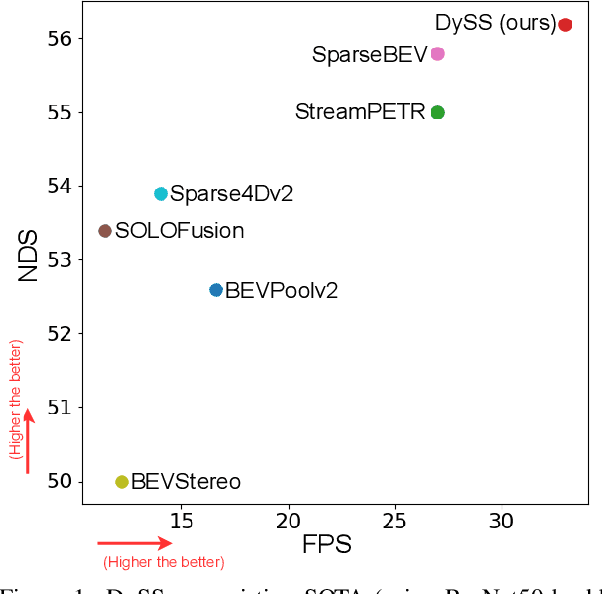
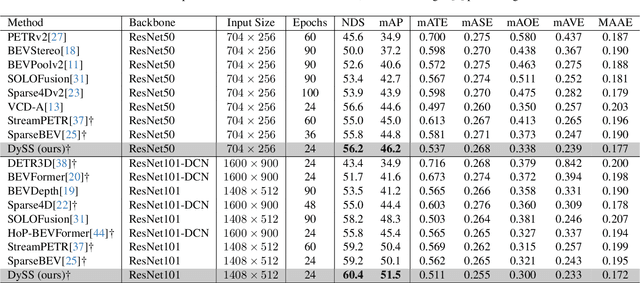
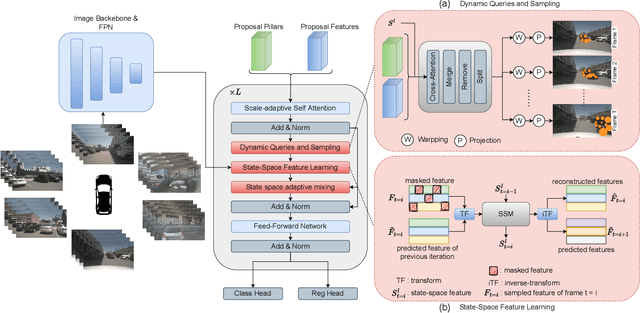
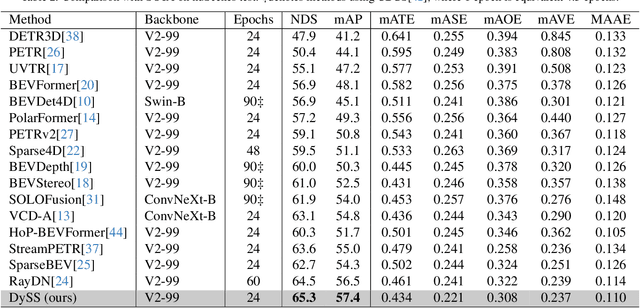
Abstract:Camera-based 3D object detection in Bird's Eye View (BEV) is one of the most important perception tasks in autonomous driving. Earlier methods rely on dense BEV features, which are costly to construct. More recent works explore sparse query-based detection. However, they still require a large number of queries and can become expensive to run when more video frames are used. In this paper, we propose DySS, a novel method that employs state-space learning and dynamic queries. More specifically, DySS leverages a state-space model (SSM) to sequentially process the sampled features over time steps. In order to encourage the model to better capture the underlying motion and correspondence information, we introduce auxiliary tasks of future prediction and masked reconstruction to better train the SSM. The state of the SSM then provides an informative yet efficient summarization of the scene. Based on the state-space learned features, we dynamically update the queries via merge, remove, and split operations, which help maintain a useful, lean set of detection queries throughout the network. Our proposed DySS achieves both superior detection performance and efficient inference. Specifically, on the nuScenes test split, DySS achieves 65.31 NDS and 57.4 mAP, outperforming the latest state of the art. On the val split, DySS achieves 56.2 NDS and 46.2 mAP, as well as a real-time inference speed of 33 FPS.
BePo: Leveraging Birds Eye View and Sparse Points for Efficient and Accurate 3D Occupancy Prediction
Jun 08, 2025Abstract:3D occupancy provides fine-grained 3D geometry and semantics for scene understanding which is critical for autonomous driving. Most existing methods, however, carry high compute costs, requiring dense 3D feature volume and cross-attention to effectively aggregate information. More recent works have adopted Bird's Eye View (BEV) or sparse points as scene representation with much reduced cost, but still suffer from their respective shortcomings. More concretely, BEV struggles with small objects that often experience significant information loss after being projected to the ground plane. On the other hand, points can flexibly model little objects in 3D, but is inefficient at capturing flat surfaces or large objects. To address these challenges, in this paper, we present a novel 3D occupancy prediction approach, BePo, which combines BEV and sparse points based representations. We propose a dual-branch design: a query-based sparse points branch and a BEV branch. The 3D information learned in the sparse points branch is shared with the BEV stream via cross-attention, which enriches the weakened signals of difficult objects on the BEV plane. The outputs of both branches are finally fused to generate predicted 3D occupancy. We conduct extensive experiments on the Occ3D-nuScenes and Occ3D-Waymo benchmarks that demonstrate the superiority of our proposed BePo. Moreover, BePo also delivers competitive inference speed when compared to the latest efficient approaches.
FALO: Fast and Accurate LiDAR 3D Object Detection on Resource-Constrained Devices
Jun 04, 2025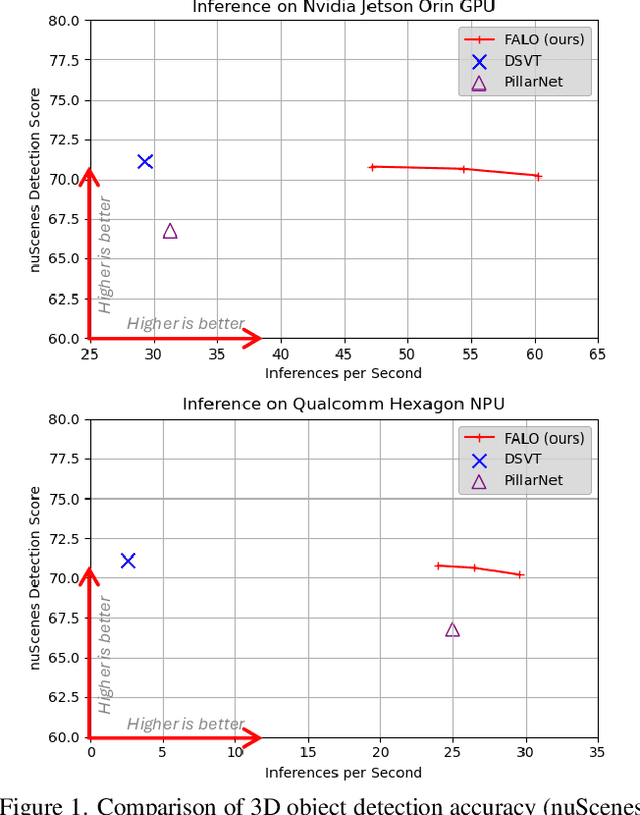
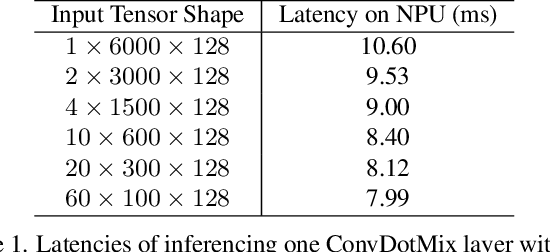
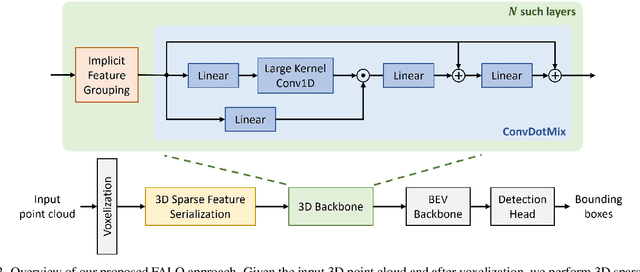
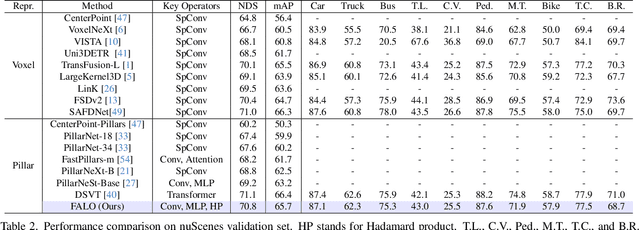
Abstract:Existing LiDAR 3D object detection methods predominantely rely on sparse convolutions and/or transformers, which can be challenging to run on resource-constrained edge devices, due to irregular memory access patterns and high computational costs. In this paper, we propose FALO, a hardware-friendly approach to LiDAR 3D detection, which offers both state-of-the-art (SOTA) detection accuracy and fast inference speed. More specifically, given the 3D point cloud and after voxelization, FALO first arranges sparse 3D voxels into a 1D sequence based on their coordinates and proximity. The sequence is then processed by our proposed ConvDotMix blocks, consisting of large-kernel convolutions, Hadamard products, and linear layers. ConvDotMix provides sufficient mixing capability in both spatial and embedding dimensions, and introduces higher-order nonlinear interaction among spatial features. Furthermore, when going through the ConvDotMix layers, we introduce implicit grouping, which balances the tensor dimensions for more efficient inference and takes into account the growing receptive field. All these operations are friendly to run on resource-constrained platforms and proposed FALO can readily deploy on compact, embedded devices. Our extensive evaluation on LiDAR 3D detection benchmarks such as nuScenes and Waymo shows that FALO achieves competitive performance. Meanwhile, FALO is 1.6~9.8x faster than the latest SOTA on mobile Graphics Processing Unit (GPU) and mobile Neural Processing Unit (NPU).
Gaussian Splatting is an Effective Data Generator for 3D Object Detection
Apr 23, 2025Abstract:We investigate data augmentation for 3D object detection in autonomous driving. We utilize recent advancements in 3D reconstruction based on Gaussian Splatting for 3D object placement in driving scenes. Unlike existing diffusion-based methods that synthesize images conditioned on BEV layouts, our approach places 3D objects directly in the reconstructed 3D space with explicitly imposed geometric transformations. This ensures both the physical plausibility of object placement and highly accurate 3D pose and position annotations. Our experiments demonstrate that even by integrating a limited number of external 3D objects into real scenes, the augmented data significantly enhances 3D object detection performance and outperforms existing diffusion-based 3D augmentation for object detection. Extensive testing on the nuScenes dataset reveals that imposing high geometric diversity in object placement has a greater impact compared to the appearance diversity of objects. Additionally, we show that generating hard examples, either by maximizing detection loss or imposing high visual occlusion in camera images, does not lead to more efficient 3D data augmentation for camera-based 3D object detection in autonomous driving.
H3O: Hyper-Efficient 3D Occupancy Prediction with Heterogeneous Supervision
Mar 06, 2025Abstract:3D occupancy prediction has recently emerged as a new paradigm for holistic 3D scene understanding and provides valuable information for downstream planning in autonomous driving. Most existing methods, however, are computationally expensive, requiring costly attention-based 2D-3D transformation and 3D feature processing. In this paper, we present a novel 3D occupancy prediction approach, H3O, which features highly efficient architecture designs that incur a significantly lower computational cost as compared to the current state-of-the-art methods. In addition, to compensate for the ambiguity in ground-truth 3D occupancy labels, we advocate leveraging auxiliary tasks to complement the direct 3D supervision. In particular, we integrate multi-camera depth estimation, semantic segmentation, and surface normal estimation via differentiable volume rendering, supervised by corresponding 2D labels that introduces rich and heterogeneous supervision signals. We conduct extensive experiments on the Occ3D-nuScenes and SemanticKITTI benchmarks that demonstrate the superiority of our proposed H3O.
Distilling Multi-modal Large Language Models for Autonomous Driving
Jan 16, 2025Abstract:Autonomous driving demands safe motion planning, especially in critical "long-tail" scenarios. Recent end-to-end autonomous driving systems leverage large language models (LLMs) as planners to improve generalizability to rare events. However, using LLMs at test time introduces high computational costs. To address this, we propose DiMA, an end-to-end autonomous driving system that maintains the efficiency of an LLM-free (or vision-based) planner while leveraging the world knowledge of an LLM. DiMA distills the information from a multi-modal LLM to a vision-based end-to-end planner through a set of specially designed surrogate tasks. Under a joint training strategy, a scene encoder common to both networks produces structured representations that are semantically grounded as well as aligned to the final planning objective. Notably, the LLM is optional at inference, enabling robust planning without compromising on efficiency. Training with DiMA results in a 37% reduction in the L2 trajectory error and an 80% reduction in the collision rate of the vision-based planner, as well as a 44% trajectory error reduction in longtail scenarios. DiMA also achieves state-of-the-art performance on the nuScenes planning benchmark.
Planar Gaussian Splatting
Dec 02, 2024



Abstract:This paper presents Planar Gaussian Splatting (PGS), a novel neural rendering approach to learn the 3D geometry and parse the 3D planes of a scene, directly from multiple RGB images. The PGS leverages Gaussian primitives to model the scene and employ a hierarchical Gaussian mixture approach to group them. Similar Gaussians are progressively merged probabilistically in the tree-structured Gaussian mixtures to identify distinct 3D plane instances and form the overall 3D scene geometry. In order to enable the grouping, the Gaussian primitives contain additional parameters, such as plane descriptors derived by lifting 2D masks from a general 2D segmentation model and surface normals. Experiments show that the proposed PGS achieves state-of-the-art performance in 3D planar reconstruction without requiring either 3D plane labels or depth supervision. In contrast to existing supervised methods that have limited generalizability and struggle under domain shift, PGS maintains its performance across datasets thanks to its neural rendering and scene-specific optimization mechanism, while also being significantly faster than existing optimization-based approaches.
 Add to Chrome
Add to Chrome Add to Firefox
Add to Firefox Add to Edge
Add to Edge